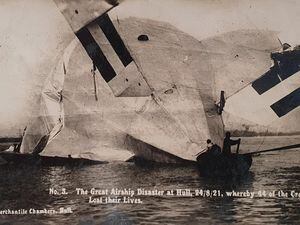New memorial project launched ahead of 100th anniversary of airship disaster
The crash in Hull on August 24 1921 left 44 people dead.

An appeal has been launched for stories and souvenirs ahead of the 100th anniversary of an airship disaster which claimed 44 lives.
The R.38/ZR-2 exploded mid-flight in front of thousands of onlookers in Hull on August 24 1921, before crashing into the Humber.
The crash left 44 of the aircraft’s 49-strong British and American crew dead.
Ahead of the anniversary, Historic England has commissioned a crowdsourcing project to create an online archive of materials relating to the disaster.
It has invited the public to come forward with family stories, documents, photos or memorabilia from the crash, which was a major event in the 20th century history of Hull.
Public funerals and memorial services took place across the city and several of the crew lie in Hull Western Cemetery, beneath the Grade II-listed airship memorial.
The region was a focal point for airships in the early 20th century. Some of the aircraft were built at the village of Barlow, near Selby, and there was an airship base at Howden, which would launch patrols to hunt for German U-boats during the First World War.

The R.38/ZR-2 was built at Cardington, Bedfordshire, but, with its British and American crews, it was based at Howden to complete its test flights.
Historic England said the airship was due to fly to Pulham in Norfolk ahead of its final handover to the US Navy, but it had to return to Howden due to bad weather.
Last checks on its steering caused the light structure of the airship to break apart, resulting in catastrophe.
Lessons learned from R.38/ZR-2 crash contributed to the design of the R100 airship which was built at Howden later in the 1920s.
Keith Emerick, from Historic England, said: “Like the Titanic, the R.38/ZR-2 was the most advanced of its kind at the time.
“It was larger, faster and could fly higher than any of its predecessors. The airship was about to be sold to the US and was only on its fourth test flight when it crashed, carrying both British and American personnel.
“The crash was a personal tragedy for the crew, their families and had huge ramifications for the future of aviation. This project offers a great opportunity for people to recount family stories about this historic event.”
The new Historic England-funded project, which is led by heritage consultancy Fjordr, will create a virtual collection of materials.
Antony Firth, director of Fjordr, said he first became fascinated with the crash after hearing about it from his grandfather, who witnessed the disaster first-hand as a young boy.
Mr Firth said: “We want to hear from people who have been told similar stories by relatives or who might have souvenirs of the crash.
“We know that a range of objects were made from the wreckage including candlesticks and ashtrays. I can’t wait to see what people come forward with.”
Fjordr do not want people to donate objects but rather allow them to be recorded to help create the online collection.
Anyone with contributions can contact the project through email on carnegiehull@hotmail.co.uk, or through Twitter – @carnegiehull44.





